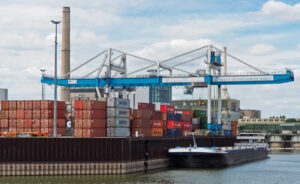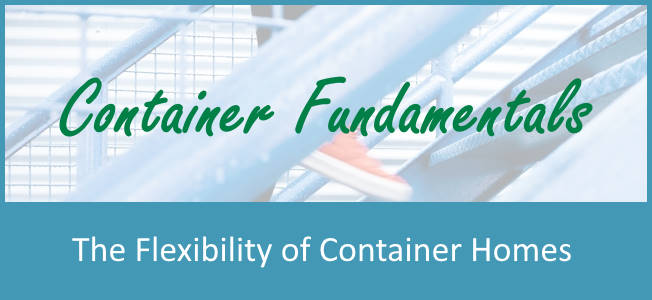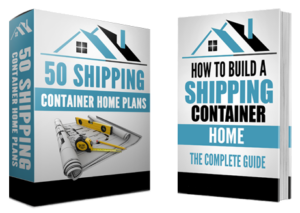Flexibility is universally valued in the world of real estate as an ability to operate outside of rigid rules and conditions. And when it comes to housing, one of the largest purchases you’ll ever make in your life, flexibility is certainly something to seek out.
With flexibility, you get options. The ability to change your mind, try a different way, or just not feel rushed.
It can be expressed in a variety of ways, including things like:
- Who will use the building, both now and in the future?
- What type of architectural style do you want?
- When do you want to start and finish the construction?
- Where do you want the building, where do you want to build it, and are they in the same location?
- How involved do you want to be in the construction?
If you see one container sitting by itself in an open field, you might not understand why everyone gets so excited about containers. But visit a port where there are hundreds of them moving about and you might start to have an idea of how flexible that could be for a homeowner.

It’s not just that a container is a strong, steel box, although that is, in itself, pretty compelling. It’s that there are thousands of containers just like it. It’s that they can be attached together front to back, side to side, and top to bottom. More importantly, it’s that the infrastructure and systems that enable them to be moved cheaply and easily already exists.
Let’s talk about how a container’s ability to be flexibly built, moved, and used impacts you as a prospective container homeowner.
Location of Construction
It’s right there in the name: shipping container. They are meant to be shipped. And they can be shipped empty or full, before or after you convert them to their ultimate use as a building. One of the biggest choices you’ll make it where to do that conversion.
Building Offsite
Building offsite allows you to control the conditions around your worksite. For instance, if you don’t have your utilities hooked up and functional at your worksite, building a container home offsite might make things easier.
Or if the weather isn’t particularly good, perhaps you want to build your container offsite inside of a climate-controlled warehouse and not have to worry about maintaining water-tightness as you modify the exterior for windows and doors.
Then there is the issue of labor. Unless you’re planning to do everything yourself, you’ll need at least some contractor help. If you’re in a more rural area, it may be difficult to find skilled contractors to help you, and easier to build the container in a more urban area first.
If you’re honest with yourself, there are some places where it’s just not realistic to economically build a traditional home. But if there is road access where a truck can get there, a container home may be a way to make this a reality.

For those intending to live in the wilderness, the cost of transporting your building materials and paying for contractors to travel that far may end up being much higher than shipping your finished container home to the site in one trip. The ‘stuff’ has to go to the site either way, either in dozens/hundreds of truckloads or all at once. The thing you aren’t having to carry hundreds of times is laborers.
Keep in mind that when we say ‘build’, there are actually two different activities involved: construct and assemble. You can never really completed finish a project offsite because there is always going to be some foundation, assembly or siting work required that usually takes at least a few days.
It’s generally more common for DIFM builds to be conducted offsite, while DIY builds are onsite. But that’s not a rule, just a trend. If you have access to a facility (whether indoors or outdoors) that could serve as a place to conduct your DIY build, offsite is available to you as well.
Some container building contractors will build for you onsite. This is especially true for larger, more custom shipping container houses. In comparison, smaller container cabins are usually fabricated offsite and delivered ready to live in.
Building Onsite
Building onsite allows you to be a little more open-ended with your planning. To some degree, you can make changes as you go because you can immediately see what the downstream effects are going to be. When you’re working offsite, it can be a little more difficult to envision how changes are going to affect everything else onsite.
If you’re planning to join and stack several containers, there are some advantages to an onsite build. You need access to the metal shell of the container in order to join them, for instance. If you build everything offsite and they are already enclosed upon arrival onsite, you may have to do some small demolition work before you can hook everything together.
One interesting option that could be useful to those with rural container projects is purchasing all needed materials and actually placing them in the empty containers before they go to the building site. This could save a lot of headaches and time later on by providing everything you need on-site on day one. Of course, it would require a lot of planning to pull it off!
Speed of Construction
Similar to how we discussed with location, the speed of construction often depends on who is doing the work. If the project is ‘do it yourself’ (DIY), you’re likely planning to draw out the timeline a bit. ‘Do it for me’ (DIFM) builds are typically a bit faster given a larger work crew and the fact that they’ve done everything before.
However, if you can convince your family and friends to offer significant help, a well-planned DIY build can be pulled off pretty quickly. And conversely, a poorly managed builder may have trouble balancing multiple projects at a time, retaining work crews, etc.
Quickly-Built Container Buildings
An appropriate question to ask is, do you need your container home built relatively quickly, and if so, why? Perhaps you need to vacate your current residence and avoid paying double rent. Or maybe you’re relocating for work and want to be move-in ready upon arrival. Sometimes, it’s just realizing the number of irons you have in the fire and choosing to minimize further impact to your life.
Whatever the reason, if you want to build your container house fast, it’s an achievable goal.
The best way to get your container project constructed hastily is to effectively plan your use of equipment, materials, and labor. Thinking through every phase of the project beforehand and ordering/scheduling everything in advance should reduce or eliminate the huge delays that sometimes sneak up in construction projects.
It’s immaterial whether you are the one doing the planning yourself, or you’re hiring your builder to do it for you. Detailed planning needs to be done.
Once again, we’ll point out the difference between construction and assembly. It may be that you care less about the time to build offsite, and much more about the actual work on-site for assembly. By using containers, you could have a finished structure with only a few days of site work. In certain situations where minimal disturbance to neighbors and the environment is necessary, this container benefit could be crucial.
Our Case Study on the Graceville Container House clearly demonstrates this fact. Todd and Di Miller built their shipping container home in Brisbane, Australia. When it came to delivery and assembly, 31 containers were brought on-site and placed on the foundations in only two days.
This equates to around 6,000 square feet of construction laid down in two days, a rate that just isn’t possible with traditional building methods. Also, the entire home only took 16 weeks to build off-site, which is pretty remarkable considering the size and specifications of the home.
Slowly-Built Container Buildings
You could argue that no one purposefully chooses to have a slowly-built container home directly, but rather, it’s a result of other constraints and choices. A few reasons include:
- Poor weather that makes access to the site impractical
- Limited financing that requires a ‘pay as you go’ approach
- Personal commitments like family obligations or vacations that take time away from the project
- Design changes late in the project
- Extensive site work that’s needed prior to even placing containers on-site
- Busy contractors that are booked up with work in advance
- Specialized or custom materials that have long order fulfillment times
Regardless of the reason, by virtue of using containers, you’re providing yourself the option to handle these types of situations. For one thing, containers are certainly used to waiting: many of them spend months of their lives stacked up, just waiting to be used for the next shipment.
Additionally, containers are weathertight, easily moveable, structurally sound, and extremely uniform. Why does that matter?
If you have to buy one batch of containers now and need more in the future, you know that they’ll all be the same size. That’s not necessarily true with something like bricks. If you get halfway through the project and have to take an extended break, the containers should be just fine. They’ll keep everything secure and out of the weather until you’re ready to start again. If you start building offsite and lose access to the space, so you need to move the work onsite mid-project, that’s entirely possible.
In short, when tackling a one-off project, especially a DIY one, it’s good to have that flexibility to work around issues and changes and oversights that will inevitably come up. By utilizing containers, you’re giving yourself a better chance of handling those situations without huge impacts on the schedule or finances. The same can’t necessarily be said for conventional construction.
A typical single-family home in the US now takes almost seven months to build, according to the US Census. Even with a team of laborers, it usually takes at least several weeks if not months to get a ‘dried in’ structure with traditional construction methods. With containers, you can have that step completed on the first day. The duration of the rest of the project is kind of up to you, as discussed above.
Portability
Typically, when you think of structures that are portable or semi-permanent, you assume you’re going to be giving up things like security and durability in return. Choices like tents, trailers, and RV’s come to mind. However, with containers, you can have a secure, durable building that is also portable if you want. Or you can make it completely permanent.
Leaving the option open on portability typically just means you’re going to bolt and clamp things together instead of weld them. This applies to both joining multiple containers together as well as attaching containers to foundations.
If you look closely at the corners of containers, you’ll see the same hole pattern repeated on all sides. This is a female connector for specially designed twist locks that rigidly connect containers vertically and horizontally while still allowing them to be separated easily. This YouTube video shows how twist locks work.
Portability can be a huge benefit if you want to own your own home but need to move often. All you’d need to do is find suitable utility hookups for your shipping container each time you move it.
Expandability
Closely related to portability is expandability. If you design your container building with the future in mind, it’s pretty easy to plan for a day where additional containers will be added to your building.
The easiest way to do this is to design what the fully built out structure might look like, even if you won’t actually build it all at once. In particular, think about how you will connect the first phase of the house to the second phase.
You’ll need an empty doorway at minimum, if not the entirety of a side of a room, in order to connect two containers side by side. Try to keep permanent fixtures like cabinets, sinks, etc. out of the area where this future connection might occur.
If you want to stack containers in the future, think about if you want internal or external staircases. Either way, you’ll need to leave room inside or outside the container for the landings and the stairs themselves.
At a future date, you’ll be able to drop a new container into your existing project with minimal demolition or reconstruction if you’ve planned correctly. It can be much easier than handling an addition with existing construction.
Off-grid Living
One additional capability that’s worth discussing is a container’s role in the concept of living off-grid. When you’re off the grid, you typically aren’t purchasing utilities from a municipality or company and instead are self-reliant and self-sufficient as much as possible. The ‘grid’ here is explicitly referring to electricity, but the broader term generally means any kind of external hookup to services provided from outside your property line.

With an off-grid home, you generate your own electricity, get your own water from a well or tank filled by a delivery truck, and handle your own waste with a septic tank. Containers are especially well-suited for off-grid living for a number of reasons.
First, the portability and flexible building location of containers allows you to build the house where you have easy access to power, tools, and supplies. Then, you can transport it to the off-grid building site. Otherwise, you’ll either be dealing with generators and hauling fuel or backbreaking manual labor without power tools.
Next, the container’s strength means that weather, wild animals, and other issues should be less of a concern when you’re far away from urban life. When you’re away from the comfort of other people and a quick response from emergency personnel, having a safe and secure house is an important concern.
Finally, the sustainability of containers means you can place your home onto the land with minimal impact on the environment. This applies not just to the site disturbance of placing a large foundation, but also the reduced carbon footprint you leave by not purchasing fossil-fuel generated electricity and by adaptively reusing an otherwise excess container.
Living off-grid is certainly a niche example of the flexibility offered by containers, but it’s certainly worth mentioning for the benefit of readers who are interested in this simpler way of life.
Summary
The flexibility of containers is all about giving yourself options. You aren’t locked into a size, building site, construction location, or timeline unless you want to be.
Instead, containers put you in the driver’s seat of your destiny and allow you to choose what, how, and when to build the perfect building for you.
Can you think of any great examples of flexibility that we’ve missed? Let us know below in the comments.




4 Responses
Excellent information.
Have bookmarked this site.
Glad you found us and thanks for reading!
Last time I ordered a container from you it took over a month to arrive. What is your current delivery times? What is the cost of containers delivered to Tombstone, AZ? Price for 40′ HC, 20′ HC and 45′ HC
Thanks, Larry
You may have us mistaken with another website. We don’t sell shipping containers directly. If you’d like more information on how and where to purchase containers, this post is a great resource: https://www.discovercontainers.com/how-to-purchase-your-shipping-containers/